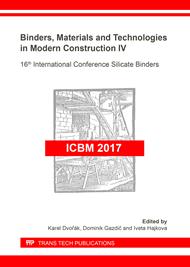[1]
A. Henry, J. Stewart, Mortars, Renders and Plasters (Practical Building Conservation), 1. English Heritage, first ed., Ashgate Publishing, Great Britain, (2011).
Google Scholar
[2]
J. Chybík, Natural building materials, first ed., Grada Publishing, Havlíčkův Brod, (2009).
Google Scholar
[3]
J. Hroudová, A. Korjenic, J. Zach, M. Mitterböck, Entwicklung eines Wärmedämmputzes mit Naturfassern und Untersuchung des Wärme- und Feuchteverhaltens, Bauphysik 39 (2017) 261-271.
DOI: 10.1002/bapi.201710030
Google Scholar
[4]
A. Braieka, M. Karkri, A. Adili, L. Ibos, S. B. Nasrallaha, Estimation of the thermophysical properties of date palm fibers/gypsum composite for use as insulating materials in building, Energy and Buildings 140 (2017) 268-279.
DOI: 10.1016/j.enbuild.2017.02.001
Google Scholar
[5]
N. Benmansour, B. Agoudjil, A. Gherabli, A. Kareche, A. Boudenne, Thermal and mechanical performance of natural mortar reinforced with date palm fibers for use as insulating materials in building, Energy and Buildings 81 (2014) 98-104.
DOI: 10.1016/j.enbuild.2014.05.032
Google Scholar
[6]
D. Sedan, C. Pagnoux, A. Smith, Mechanical properties of hemp fibre reinforced cement: influence of the fibre/matrix interaction, J. Europ. Ceram. Soc. 28 (2008) 183-192.
DOI: 10.1016/j.jeurceramsoc.2007.05.019
Google Scholar
[7]
R. MacVicara, L.M. Matuanab, J.J. Balatinecza, Aging mechanisms in cellulose fiber reinforced cement composites, Cem. Concr. Composit. 21 (1999) 189-196.
Google Scholar
[8]
Z. Li, X. Wang, L. Wang, Properties of hemp fibre reinforced concrete composites, Compossit. Part A: App. Sc. and Manuf. 37 (2006) 497-505.
DOI: 10.1016/j.compositesa.2005.01.032
Google Scholar
[9]
A. Bouguerra, O. Amiri, A. Ait-Mokhtar, M. B. Diop, Sorption de l'eau et structure des pores de matériaux composites ciment-bois (Water sorptivity and pore structure of wood–cementitious composites), Magazine of Concrete Research 54 (2002).
DOI: 10.1680/macr.2002.54.2.103
Google Scholar
[10]
M. Bederina, L. Marmoret, K. Mezreb, M.M. Khenfer, A. Bali, M. Quéneudec, Effect of the addition of wood shavings on thermal conductivity of sand concretes: experimental study and modelling, Constr. Build. Mat. 21 (2007) 662-668.
DOI: 10.1016/j.conbuildmat.2005.12.008
Google Scholar
[11]
A. Ledhem, R.M. Dheilly, M.L. Benmalek, M. Quéneudec, Properties of woodbased composites formulated with aggregate industry waste, Constr. Build. Mat. 14 (2000) 341-350.
DOI: 10.1016/s0950-0618(00)00037-4
Google Scholar
[12]
V. Corinaldesi, J. Donnini, A. Nardinocchi, Lightweight plasters containing plastic waste for sustainable and energy-efficient building, Constr. Build. Mat. 94 (2015) 337-345.
DOI: 10.1016/j.conbuildmat.2015.07.069
Google Scholar
[13]
B.S. Al-Tulaian, M.J. Al-Shannag, A.R. Al-Hozaimy, Recycled plastic waste fibers for reinforcing Portland cement mortar, Constr. Build. Mat. 127 (2016) 102-110.
DOI: 10.1016/j.conbuildmat.2016.09.131
Google Scholar
[14]
S. Romaniega Piňeiro, M. Del Río Merino, C. Pérez García, New Plaster Composite with Mineral Wool Fibres from CDW Recycling, Adv. Mat. Sc. Eng. (2015) 1-9.
DOI: 10.1155/2015/854192
Google Scholar
[15]
F. Iucolano, B. Liguori, C. Colella, Fibre-reinforced lime-based mortars: A possible resource for ancient masonry restoration, Constr. Build. Mat. 38 (2013) 785-789.
DOI: 10.1016/j.conbuildmat.2012.09.050
Google Scholar
[16]
C. Aciu, D.A.I. Varvara, N. Corbirzan, A. Balog, Recycling of Paper Waste in the Composition of Plastering Mortars, Proc. Techn. 12 (2014) 295-300.
DOI: 10.1016/j.protcy.2013.12.489
Google Scholar
[17]
A.F. Angelin, M.F.F. Andrade, R. Bonatti, R.C. Cecche Lintz, L.A. Gachet-Barbosa, W.R. Osório, Effects of spheroid and fiber-like waste-tire rubbers on interrelation of strength-to-porosity in rubberized cement and mortars, Constr. Build. Mat. 95 (2015).
DOI: 10.1016/j.conbuildmat.2015.07.166
Google Scholar
[18]
B. Yesilata, Y. Isiker, P. Turgut, Thermal insulation enhancement in concretes by adding waste PET and rubber pieces, Constr. Build. Mat. 23 (2009) 1878-1882.
DOI: 10.1016/j.conbuildmat.2008.09.014
Google Scholar
[19]
N. Stevulova, I. Schwarzova, V. Hospodarova, J. Junak, Implementation of Waste Cellulosic Fibres into Building Materials, 2nd International Conference on Biomass (ICONBM 2016), Chemical Engineering Transactions, 50 (2016) 367-372.
Google Scholar


